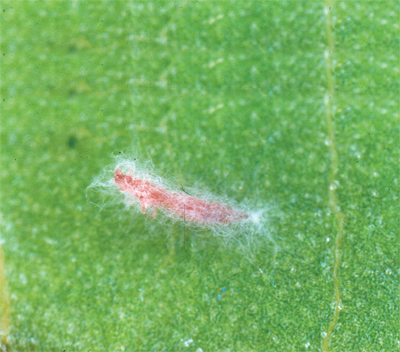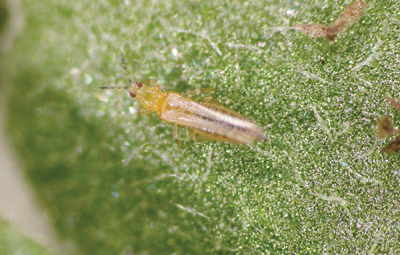
Biological control is increasingly being successfully used by growers
to manage pests and diseases in greenhouse floriculture crops.
Biological control is increasingly being successfully used by growers to manage pests and diseases in greenhouse floriculture crops. There are a number of drivers behind this move:
- Pesticide options continue to decline as a result of resistance, or withdrawal of older chemistries from the market.
- Health and safety regulations that make it difficult to accommodate some materials into a spray program.
- Consumer demand for residue-free plants.
 |
|
| Western flower thrips infected with Beauveria bassiana.
|
And there are many benefits, including no (or minimal) re-entry delays after the release or application of a biocontrol agent so that other management practices for a specific crop are not disrupted, and provision of a better work and sales environment. Couple this with the fact that by using biologicals, development of resistance is slowed, and it is easy to see why they are such an attractive alternative.
There are many instances, though, when pesticides may still have to be used – for example, if pest populations are rapidly expanding or were detected late, and need to be quickly brought under control. Alternatively, more than one pest or disease may have to be controlled and natural enemies may not be an option for both. Or, environmental conditions may impede the performance of a natural enemy (e.g., low lighting levels, low temperature).
So, pesticides have an important role to play, but can they be utilized without compromising a biocontrol program, or opportunities to implement one?
SOME PESTICIDES ARE DIRECTLY COMPATIBLE WITH NATURAL ENEMIES
Happily, they can! Some pesticides are directly compatible with natural enemies as the active ingredient does not affect the biocontrol agent. For example:
- ‘Forbid’ can be used together with the parasites Encarsia and Eretmocerus to control whiteflies.
- The fungal biopesticide ‘BotaniGard’ (recently registered in Canada) is generally compatible with parasites and predators used to control whiteflies or thrips.
- ‘Dipel’, another biopesticide used against caterpillars, is safe for natural enemies.
- ‘Floramite,’ which in spite of it being an acaricide, is actually compatible with predatory mites.
A word of caution, though – some of the carriers or formulation ingredients used in a pesticide may be insecticidal, even if the active ingredient is not. Some emulsifiable oils, for instance, have short-term repellant effects owing to the volatile compounds given off as spray residues dry. Also, many older fungicides are also insecticidal.
CHECK SUPPLIER WEBSITES FOR SIDE EFFECT GUIDES
Information on compatibility can be found online in side effects guides on the websites of biocontrol producers and suppliers. Local extension specialists have a wealth of knowledge to bring to the table as well. However, the information is intended as a guide only. Side effects are generally determined in acute toxicity studies where the natural enemies are exposed once to a pesticide. There may be other side effects at the sub-lethal level, so pesticide use should be minimized.
 |
|
| Western flower thrips.
|
The two control agents may also be compatible as a result of their being separated in time and space – meaning that they may be applied at different times to the crop, or to different parts of the crop and do not directly contact one another. A chemical treatment may be needed to quickly knock down a pest population before natural enemies are released. As long as the pesticide has short residual activity, it can be used successfully with a biological, as the active ingredient will effectively have disappeared from the crop once the natural enemy is released.
Alternatively, a pesticide may be used towards the end of a production cycle to clean up a crop before shipment or sale, so there is no need to preserve the natural enemies at this point.
PROPAGATING UNDER STRICT BIOCONTROL REGIMEN MEANS CROP STARTS WITH NO RESIDUES
Lastly, if propagation is done under a strict biocontrol regimen, then the crop starts clean with no residues. A biocontrol program can be maintained during finishing, with the option of using a pesticide as needed.
What about “separation in space?” Essentially, the two control agents are applied to different parts of a crop. For example, treatment of hot spots means that natural enemies will be conserved in untreated areas and will re-populate treated areas over time. Application of an insecticide or fungicide to foliage will have minimal impact on natural enemies applied to the soil for fungus gnat or thrips control, such as nematodes, or the predators Atheta or Hypoaspis. Similarly, drench treatments applied to the media will have minimal impact on natural enemies in the canopy.
Finally, the way in which a biocontrol agent is used will determine whether a pesticide can be incorporated into a management program. When using predatory mites such as Amblyseius swirskii or A. cucumeris against thrips, for example, the mites are introduced at regular intervals over a growing cycle. The releases are not made with the intent of the natural enemy becoming established within the pest population. Consequently, while an application of a broad spectrum insecticide such as DDVP (dichlorvos) will kill the resident predators in a crop, the pesticide has limited residual activity and within one to two days mites can be reintroduced.
So, there are several ways in which pesticides can be used without compromising a biological control program, but to do this successfully, there are some key points to consider. As much as possible, the more you can plan ahead, the better. Knowing which materials are compatible and how the natural enemies are used ahead of time allows you to make better choices.
Pesticide selections should be based on known side effects, their persistence, how and where they are applied, and what they are being used against. Make sure all of the materials being used in the program are compatible. And, importantly, keep assessing the performance of the control strategy; is it meeting your needs, are there other options that may be considered? The more knowledge you have, the better equipped you’ll be to successfully use biologicals and pesticides together in an IPM program.
VINELAND RESEARCH AND INNOVATION CENTRE
Vineland Research and Innovation Centre (VRIC) is an independent, not-for-profit organization established as a world-class centre for horticultural science and innovation. In its capacity to enable and foster relationships with industry, academia and government, Vineland works to deliver premium horticultural products and production innovations. The centre brings a global perspective to the horticulture industry and offers a broad range of lasting benefits both locally and internationally. Vineland’s research priorities align with industry needs and its outcomes focus on the growth of the entire horticulture industry. ■
Dr. Michael Brownbridge is the research director of Horticultural Production Systems at VRIC. • 905-562-0320, ext. 798, michael.brownbridge@vinelandresearch.com.
Print this page